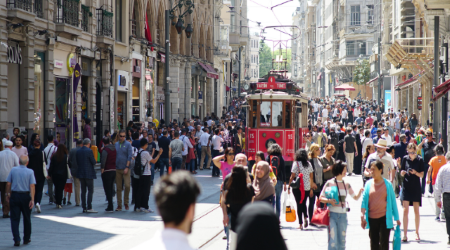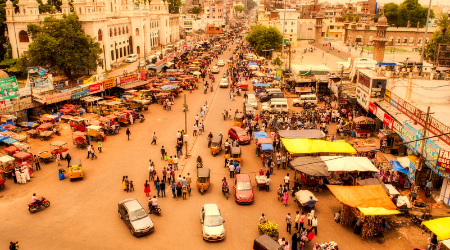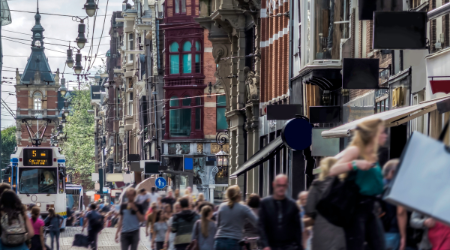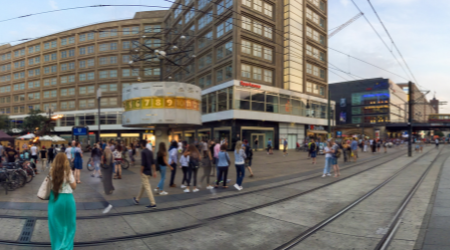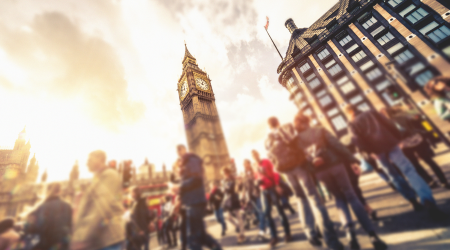War in Ukraine: A View from Poland
April 11, 2022 | Report
I was born and grew up in northeastern Poland. I obtained my education in Poland, including a master’s degree in economics. I moved to New York in 2002, but my entire immediate family is still living in the same town I grew up in. While I was in elementary school, the political system was changing right in front of my eyes. It is still very fresh in my memory thinking about the Communist Party collapse in Poland and all the systemic changes that followed. Very often I speak to my oldest daughter about all the historical events that were unraveling in front of my eyes as a little girl. I felt a tremendous joy among people who finally felt that they are free, and they can organize and rule their country in a democratic way. The hunger for freedom was so powerful that people were not afraid to take any challenge and work hard in the new social and economic environment. Although during this time we were lucky and did not need to fight in the war for our freedom, we can relate to the Ukrainians’ struggle. That invisible bond with our neighbors pushes entire Polish communities, not only in Poland, but around the world, to help Ukrainian people to fight for freedom. They were denied for so many years, same as us.
My children study in weekend school in New York learning Polish. As a school community, we connected with an orphanage in Poland, which we help on regular basis around holidays. Orphanages in Poland on February 24 knew that Ukrainian orphans would be fleeing eastern cities, like Mariupol, and under supervision of their teachers would be heading west to Poland. Within three weeks of the attack, we already were collecting money and goods to support children from Ukraine. The response has been overwhelming, from Polish people but also a number of my American friends poured their heart out and helped with purchasing goods for little refugees, who had to conquer part of the trip from Mariupol on foot.
Since the start of the war in Ukraine, 4.32 million Ukrainians have fled the country. Out of that, over 2.5 million, mostly women and children, crossed the border with Poland.
Based on the most recent census data, Poland’s population stands at 38.18 million people. Migration of over 6.5 percent of its population is not an easy task for Poland or any other country to handle on multiple fronts. Just to put this into perspective, the 2015 refugee crisis in Europe from sub-Saharan Africa and the Middle East brought to the continent around 1.83 million people. That is less than half of the number of Ukrainians fleeing their country in the matter of a little over a month.
All Polish nonprofit humanitarian institutions supported by international organizations are coordinating the first line of assistance for people who are crossing Polish borders with Ukraine. Also, a massive number of volunteers are helping with the initial settlement for newly arriving people (who are in dire physical and mental condition) with places to stay, food, and basic supplies.
Some of the refugees are in Poland only in transit trying to reconnect with relatives either in other European countries or North America. Canada, for example, simplified its visa application with Canada-Ukraine Authorization for Emergency Travel and close to 100,000 people applied for it in Poland alone. However, most are staying in Poland since they are hoping to get back to Ukraine as soon as possible, while fathers and husbands are still left behind. Also, before the war, Ukrainians were the largest group of economic migrants to Poland, so refugees might have some friends and relatives living in Poland for a while who they can connect with.
The Polish government, on the other hand, is mobilizing help for Ukrainians who decide to settle in Poland. Social services are working tirelessly to make sure that everyone will be able to register to receive benefits. The crucial aspects of governmental help comes down to housing, health care, education, and employment. In the aspect of housing, the general population was able to hugely assist incoming refugees by taking them into their houses or placing them in any vacant properties they own. Health care and education are handled by governmental spending, as a part of the public social benefit system.
The campaign in Poland to help Ukrainians refugees as well as those left in Ukraine is very widespread, like nothing ever seen before by Poles—starting from bins in each grocery store across the country, which collect goods for people, to big charity concerts and humanitarian convoys traveling back to Ukraine with supplies. There are military supplies, supported by our NATO allies, to medical equipment, medications, and anything else needed to survive on the ground in an attacked neighboring country.
Poland’s spending will dramatically increase with current crisis, which certainly will put lots of pressure on its budget. Since the change of political regime in 2015 parliamentary elections, from liberal to very conservative, the public social expenditure as a percentage of GDP has been increasing. It surpassed not only the average for all OECD countries but has been the largest among all post-communist eastern European countries.
The Polish government is pleading with European Union and with the U.K. to assist with as much funds as possible. Besides financing healthcare and education to refugees, Polish government will start providing cash subsidy in the form on 500 Polish zloty (around 120 USD, approximately 105 euros) for each child until age 18, who will be registered by social services. Additionally, all war refugees are eligible for free of charge train transportation while traveling in Poland.
Help for Ukrainians untied all political fronts in Poland like probably no other issue for a very long time. We feel connected to our Slavic brothers and sisters in the fight for independence. Poland fully understands that independent and democratic Ukraine is the only guarantor of peace, so helping Ukraine is in our and NATO’s interest. Anti-Russian rhetoric in Poland has been prominent on all fronts, starting with official statements, through official media and social media.
However, we are still dependent on Russian energy, with fossil fuels being the biggest part of Polish import from Russia. Currently Poland is working on a new internal legal framework that would stop the import of coal from Russia and from the Russian-occupied region of Donbas and Lugansk. Over 80 percent of coal needed in Poland is produced locally and the plan is to substitute Russian supply with either local production before the fall of 2022, and immediately with imports from the Czech Republic and Australia.
Poland is also experiencing its highest inflation rate in over 20 years. That will translate into less purchasing power for the general population, since the rise in wages is being outpaced by rising prices. However, if the war in Ukraine is prolonged and many of the refugees who will settle in Poland are employed, even temporarily, their contribution will fuel additional demand which will have a positive outcome for the economy overall.
In terms of GDP, the Polish economy rebounded swiftly from the pandemic recession compared to other major European economies, with GDP levels at the end of last year 5 percent above prepandemic levels. After growing by 5.6 percent for the year as a whole in 2021, a similarly strong figure was expected for 2022. Since the war however The Conference Board downgraded this number to 3.8 percent, with the largest hit to GDP expected to manifest itself in the figures for the second quarter. This downgrade reflects disruptions to the economy brought about by the conflict in Ukraine, particularly as it exacerbates already high inflation. In our central scenario we estimate the conflict to push up inflation in Poland to 11 percent on average for 2022, up from the 7.7 percent pre-conflict forecast. The Polish central bank has already responded with several rate hikes, with the policy rate currently already at 4.5 percent, and there is more to come which will cool the economy.
AUTHOR
-
Complimentary.







